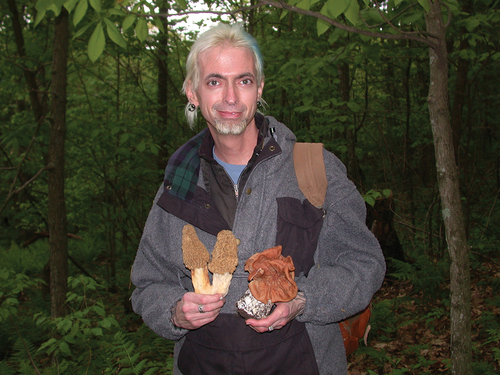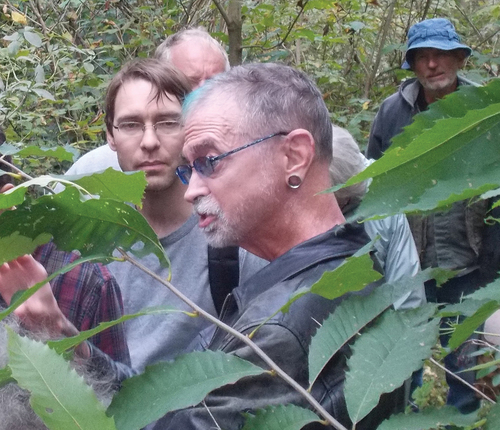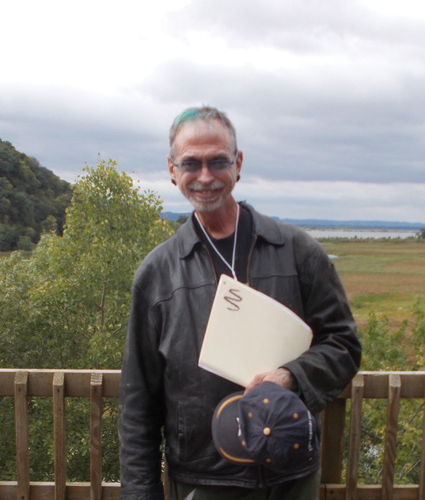On 28 November 2022, the mycological world lost arguably the most widely known and loved North American mycologist of our time, Dr. Thomas J. Volk. “Tom” passed away at his home in La Crosse, Wisconsin.
Tom was born 28 January 1959, in Girard, Ohio, to Thomas Ivan and Rose (Criscione) Volk and grew up in Warren, Ohio. He demonstrated an early interest in the natural world, spending time playing around the creek bed with his sister, Roseanne, in the woods across the street from his home. He was a bright kid and skipped fourth grade in his early years. Tom also developed an early interest in music, and from age 12 through his high school years at John F. Kennedy High School and up to age 21 he was a member of the Warren (“Squire’s”) Junior Military Band, composed of youth from northeastern Ohio. After aging out of the band, he maintained his involvement, serving as a coach/instructor for many years, even after he moved to Wisconsin for graduate school and beyond.
Tom continued his education, remaining in Ohio at Ohio University (OU), where he majored in botany. During his tenure, Tom was the recipient of several scholarships and the Botanical Society of America’s “Young Botanist Award.” He was an undergraduate researcher on projects including a study on the effects of salt concentration on seed germination and another on the effect of pH on nitrogen fixation rates of birdsfoot trefoil in coal spoils. During his time at OU, he came under the influence of Dr. James Cavender, who sparked his interest in the fungi. (Tom also credited the realization that he could find free food.) He completed a stellar undergraduate career, including membership in Phi Beta Kappa, with a Bachelor of Science degree, summa cum laude, in botany in June of 1980.
An interest in fungi, genetics, and physiology led Tom to pursue a graduate degree under Dr. Thomas J. Leonard in the Department of Botany at the University of Wisconsin, Madison. His early work with Dr. Leonard involved research on genetics and development of Schizophyllum commune, but after several years Tom switched to studying the development of morel (Morchella) ascomata. This work resulted in a dissertation entitled “Experimental Studies on the Morel” for his Ph.D. degree in 1988 and a research interest in Morchella that would last throughout his career ().
Figure 1. Tom displaying two of his favorite “mushroom” genera, Morchella and Gyromitra (morels and false morels), May, 2011. Photograph by Dan Lindner.

With Ph.D. in hand, Tom changed course, signing on with the Center for Forest Mycology Research (CFMR), United States Department of Agriculture (USDA) Forest Service, Madison, Wisconsin, in late 1989. There, he worked on biosystematics of wood-inhabiting fungi. Although intended to be a short-term stint, the position with the CFMR developed into a six-and-a-half-year venture. His work included identifying basidiomycetes from across North America as well as other parts of the world. His work resulted in coauthoring several mycobiota/checklists and taxonomic contributions to Armillaria and Laetiporus. He developed collaborations not only with North American mycologists but also with students and cooperators from several tropical countries. During this time, he also began reaching out to groups beyond the professional research community and served as a resource for the University of Wisconsin Poison Control Center, identifying potentially poisonous mushrooms. During his stay at the CFMR, he also expanded his contacts to the North American Mycological Association (NAMA), other nonprofessional mycological societies, and local naturalist groups, offering presentations and field trips with information on mushrooms and their biology. During this time, he also began his association with the Alexander H. Smith Lake States Mycological Foray, an annual gathering of upper Midwest mycologists and students. Tom was a regular attendee, usually with a covey of students in tow, and he served as host/co-host of several “Smiths” over the years ().
Figure 2. Tom in the forest, his favorite classroom, gathered around a surviving American chestnut tree with Todd Osmundson, Chuck Soden, and John Steinke behind him. Alexander H. Smith Mycological Foray, near La Crosse Wisconsin, 2013. Photo by Hal Burdsall.

Figure 3. Tom at the 2013 Smith Foray near La Crosse, Wisconsin, with the Mississippi River in the background. Photograph by Hal Burdsall.

In August of 1996, Tom was hired as an assistant professor of biology and microbiology at the University of Wisconsin–La Crosse (UWL). It turned out to be a match made in heaven. The UWL department and Tom Volk seemed to be made for each other. Tom was taking over for the recently retired Dr. Allen Nelson who had established a quality mycology/microbiology program at UWL, and Tom was excited about carrying it on with his own innovations. During his 27 years there, Tom did exactly that. His talent for teaching and his broad knowledge of mycology put UWL on the map for a high-quality mycology education at the undergraduate and master’s levels. As a professor at UWL, Tom taught “Mycology,” “Medical Mycology,” and “Plant-Microbe Interactions” to over 1500 undergraduate students, was instrumental in building an official undergraduate concentration in Plant and Fungal Biology (possibly the only undergraduate degree program in fungal biology in the United States), and elevated fungi to “equal time” coverage with plants and animals in the 10-week comparative Biology component of Organismal Biology, a second-semester core course for undergraduate biology majors. With Dr. Todd Osmundson, he co-taught a graduate course entitled “21st Century Mycology,” the goal of which was to prepare graduate students to be well versed enough in contemporary mycological topics and methods to be able to understand any talk presented at a Mycological Society of America (MSA) conference; the course was based on recent (and some not-so-recent) journal articles and used video conferencing to allow students to interact with some of the papers’ authors. He even taught a very popular course in Latin and Greek for biologists, one of few such courses in the country. He advised or co-advised nearly 40 master’s degree thesis students, several of whom have gone on to complete doctoral degrees and establish mycology careers in government and the private sector.
As a researcher, Tom took the somewhat unorthodox approach of remaining a generalist and establishing an eclectic, student-driven research program that evolved with the interests of his graduate students. Tom described the benefits of this approach in his 2018 MSA Presidential Address, with a breadth of research spanning disciplines from taxonomy to ecology, cultivation technology, radiation physiology, mycology of coal deposits, sporocarp development, bioremediation, natural products chemistry, and medical mycology. Despite this lack of narrow research specialization and despite his position at a non–doctoral degree granting institution, Tom and his students have made important research contributions, including elucidating the Morchella (morel mushroom) life cycle, providing experimental evidence of mycorrhizal associations in Morchella, providing experimental evidence of the direction of parasitism in the “aborted Entoloma” carpophoroid, and making important contributions to the taxonomy of Armillaria, Cantharellus, Hydnellum, and Morchella.
Tom’s impact and influence grew in the mycological field not only through his academic pursuits but also through his service to the Mycological Society of America and other mycological organizations. He served on numerous committees in the MSA, established the John W. Rippon student award for research in medical mycology, and served for many years as the society’s unofficial photographer, capturing foray, award, and meeting photos that documented MSA’s annual conferences. The same is true of his service to the North American Mycological Association, where he served as a scientific advisor and was a regular professional presenter and long-serving member of several committees connecting community mushroom clubs and professional mycology. Tom was a highly regarded member of both groups: MSA recognized Tom with the William H. Weston Award for Teaching Excellence in Mycology and the MSA Fellow Award and elected Tom as its 2017–2018 president, and NAMA recognized Tom with its Award for Contributions to Amateur Mycology.
Tom was the first mycological rock star of the Internet age. His pioneering Web site, Tom Volk’s Fungi (http://botit.botany.wisc.edu/toms_fungi) with its popular “Fungus of the Month” feature, was launched in 1995 and has provided accurate and well-referenced information, permeated with Tom’s sense of humor, to probably millions of people (the home page alone had received nearly a million hits as of the last published count in 2010). He was interviewed for numerous news articles and podcasts. He was also an in-demand speaker at North American Mycological Association forays and at mycology clubs throughout the United States—he lectured to mushroom clubs in over 40 U.S. states, and his humorous and informative presentations such as “Spores Illustrated” and “The Seven Deadly Sins Committed by Fungi” always drew a crowd. Illustrative of his status among mushroom enthusiasts, Tom appears in Eugenia Bone’s popular book Mycophilia 23 times.
Tom took mycology to literally every corner of the United States. His lecture schedule was always full. Tom brought in thousands of dollars in honoraria through these many lectures. This money was placed in a special fund for support of travel for his students to forays where they could meet other mycologists and to meetings where they offered presentations on their research. His students always came first.
It was also in La Crosse where he reestablished his association with his marching band roots, becoming involved with the Blue Stars Drum and Bugle Corps in 2008. He served as a volunteer, especially in their food service for 15 years, until his death. He was well known in the group for his constant good nature and supportive attitude. He was also a strong financial supporter of the group, providing thousands of dollars of scholarship money to assist its members. He also made two major donations that allowed the purchase of a new equipment trailer and then later a new food service truck.
Unfortunately, Tom was never physically operating at 100 percent (frequently nowhere near that) because of his various serious maladies. In addition to having diabetes, Tom was diagnosed in 1997 with Hodgkin’s lymphoma. The resulting radiation therapy caused severe damage to his heart, and in 2006 he received a heart transplant. He dealt with the impact of these issues on his life with exceptional grace and never complained about the discomfort caused by his illnesses. His approach was to be thankful to be alive and able to “play mycologist” and enjoy it. “Every day is a good day,” was one of Tom’s most common remarks. Tom always expressed thanks to the anonymous heart donor for allowing him to live and grow as a mycologist. He actually talked his doctors out of his original heart, which he kept on his desk within a mushroom-themed “heart cozy” made of felted wool colored with mushroom-derived dyes. He and the heart went on the road making presentations as “The Professor with Two Hearts,” speaking about the importance of organ donations and what someone’s donation had allowed him to do. These presentations included the TEDx talk “A Change of Heart: My Transplant Experience.” He put more than 16 years on that donated heart, never neglecting to give thanks to the unknown person and the loved ones who allowed him to use it, giving him the chance to make thousands of friends and instruct thousands of people at all levels of interest in mycology. Being subject to so many ailments, Tom began to decorate himself since it was the one thing about his body over which he felt he had any control. With his mycological-themed tattoos, brightly colored hair, ear gauges, and kilts, Tom modeled to his students that it is okay to be different. At a memorial for Tom on the UWL campus, several students described how Tom’s self-expression validated their own journeys of self-discovery. Tom felt great joy for the simple fact of being alive. He urged friends and colleagues to “enjoy their good dishware every day” instead of saving it for a special occasion, to “honor people while they are still alive to appreciate it,” and to “not sweat the small stuff.”
We feel confident in saying that few, if any, people will ever have a greater impact on mycology at so many levels and have so many mycological friends as did Tom Volk. He is greatly missed by many.
Survivors include his sister, Rosanne (Jack) Rogers of Ohio and the thousands of students and friends whose lives he touched. Tom was preceded in death by his parents.
Tom and both of his hearts were cremated, and his sister Rosanne and her husband are spreading Tom’s ashes in little bits as they travel the country in their recreational vehicle. As a result, Tom will continue to have a presence far and wide, much like the knowledge, friendship, and kindness that he so generously distributed during his lifetime.
